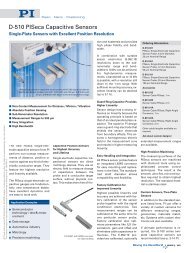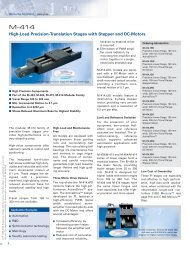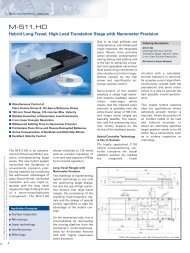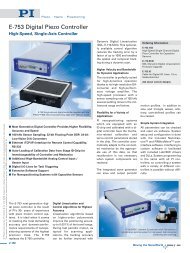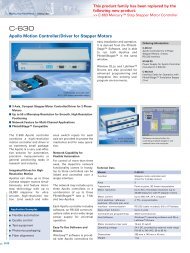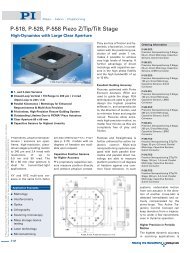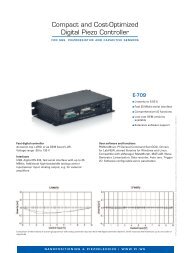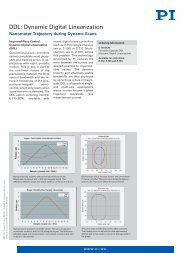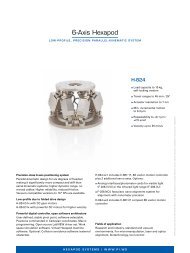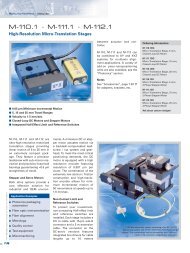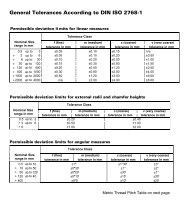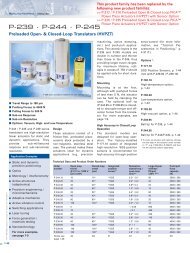Piezoelectrics in Positioning - PZT & Piezo Actuators: Sub ...
Piezoelectrics in Positioning - PZT & Piezo Actuators: Sub ...
Piezoelectrics in Positioning - PZT & Piezo Actuators: Sub ...
Create successful ePaper yourself
Turn your PDF publications into a flip-book with our unique Google optimized e-Paper software.
<strong>Piezo</strong> • Nano • Position<strong>in</strong>gQuick Facts (cont.)© Physik Instrumente (PI) GmbH & Co. KG 2008. <strong>Sub</strong>ject to change without notice.Cat120E Inspirations2009 08/10.182-180Open- and Closed-Loop OperationIn contrast to many other types ofdrive systems, piezo actuators canbe operated without servo-control.The displacement is approximatelyequal to the drive voltage.Hysteresis, nonl<strong>in</strong>earity and creepeffects limit the absolute accuracy.For position<strong>in</strong>g tasks which requirehigh l<strong>in</strong>earity, long-term stability,repeatability and absolute accuracy,closed-loop (servo-controlled) piezoactuators and systems areused (see p. 2-199). With suitablecontrollers, closed-loop operationenables reproducibilities <strong>in</strong> thesub-nanometer range.High-Resolution Sensors forClosed-Loop OperationLVDT (l<strong>in</strong>ear variable differentialtransformer), stra<strong>in</strong> gauge andcapacitive sensors are the mostcommon sensor types used forclosed-loop operation. Capacitivesensors offer the greatest accuracy.For more <strong>in</strong>formation, see p. 2-187 ff.Dynamic BehaviorA piezo actuator can reach its nom<strong>in</strong>aldisplacement <strong>in</strong> approximatelyone third of the period of its resonantfrequency. Rise times on theorder of microseconds and accelerationsof more than 10,000 g arepossible. This feature makes piezoactuators suitable for rapid switch<strong>in</strong>gapplications such as controll<strong>in</strong>g<strong>in</strong>jector nozzle valves, hydraulicvalves, electrical relays, opticalswitches and adaptive optics. Formore <strong>in</strong>formation, see p. 2-192 ff.Power Requirements<strong>Piezo</strong> actuators behave as almostpure capacitive loads. Static operation,even hold<strong>in</strong>g heavy loads,consumes virtually no power. Indynamic applications the energyrequirement <strong>in</strong>creases l<strong>in</strong>early withfrequency and actuator capacitance.At 1000 Hz with 10 μmamplitude, a compact piezo translatorwith a load capacity ofapprox. 100 N requires less than10 W, while a high-load actuator(> 10 kN capacity) would use severalhundred watts under the same conditions.For more <strong>in</strong>formation, seep. 2-195 ff.Protection from MechanicalDamage<strong>PZT</strong> ceramics are brittle and cannotwithstand high pull<strong>in</strong>g or shearforces. The mechanical actuatordesign must thus isolate theseundesirable forces from the ceramic.This can be accomplished bymeasures such as spr<strong>in</strong>g preloads,use of ball tips, flexible coupl<strong>in</strong>gs,etc. (for more mount<strong>in</strong>g guidel<strong>in</strong>es,see p. 2-216). In addition, theceramics must be protected frommoisture and the <strong>in</strong>trusion of foreignparticles. Close contactbetween the piezo mechanics manufacturerand the user facilitatesf<strong>in</strong>d<strong>in</strong>g an optimal match betweenthe piezo system and the applicationenvironment.Fig. 4. <strong>Piezo</strong> actuator with water-proof case and connection for flush<strong>in</strong>g/cool<strong>in</strong>g air



